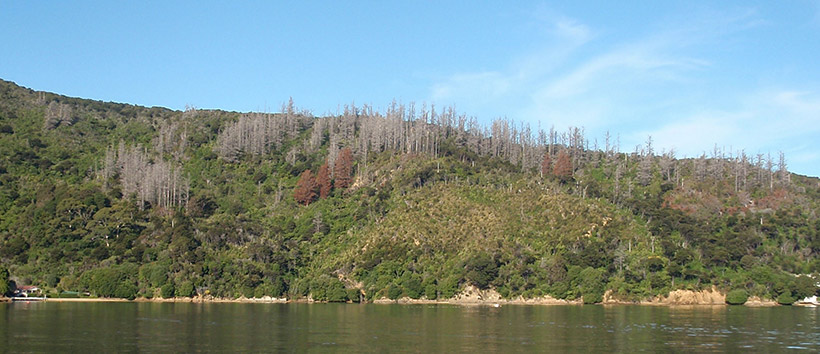Welcome to Tawa Saddle. Sit back and take in the great view of Punaruawhiti/Endeavour Inlet. Nearby you might see brown, dying trees – self-seeded pines that have been poisoned. They have spread here from nearby plantations, are unwanted, and are a threat to biodiversity.
Planting introduced pine trees for commercial forest farming began in the Marlborough Sounds in the 1930s and plantation forestry is now well established throughout the wider Marlborough Sounds. Many self-seeded, wilding pine trees grow near the Queen Charlotte Track and a few track sections pass through stands of pines.
A programme to control wildling pines is being undertaken by the Marlborough Sounds Restoration Trust, to protect scenic values and allow native forest to regenerate.

Poisoned wilding pines above Ngakuta Bay. Small amounts of herbicide are injected into holes drilled in the trunk, with smaller trees either pulled out by hand or cut down with a pruning saw
Image:Marlborough Sounds Restoration Trust ©
Changing times
Back in the 1930s when plantation forests were being established, much of the Sound had been cleared of native forest and converted to pasture for sheep and cattle. Hindsight showed that the steep, slip-prone land of the western facing slopes of Queen Charlotte Sound, was not suited to farming. The isolation of the farms made for a harsh and sometimes dangerous lifestyle.
In 1949, a local farmer, Albert Hayward, was driving sheep towards a farm gate that stood on Tawa Saddle. He fell from a peak above Tawa Bay and broke his neck. Despite people coming from all over the Sound to help, it took several days to find him. By then it was too late. Albert had been burning patches of scrub on his isolated farm. It is thought he probably stumbled in the smoke.
‘Burn-offs’ were a standard farming method of the time and working alone, in isolation, was common practice. Not long after this incident the Hayward lease was surrendered to the Crown, the land became Scenic Reserve, and was left to regenerate.
Much of the land of the Queen Charlotte Track came from farm leases that were surrendered to the Crown during the middle years of the 1900s. The power of native forest regeneration is evident all along the Queen Charlotte Track.